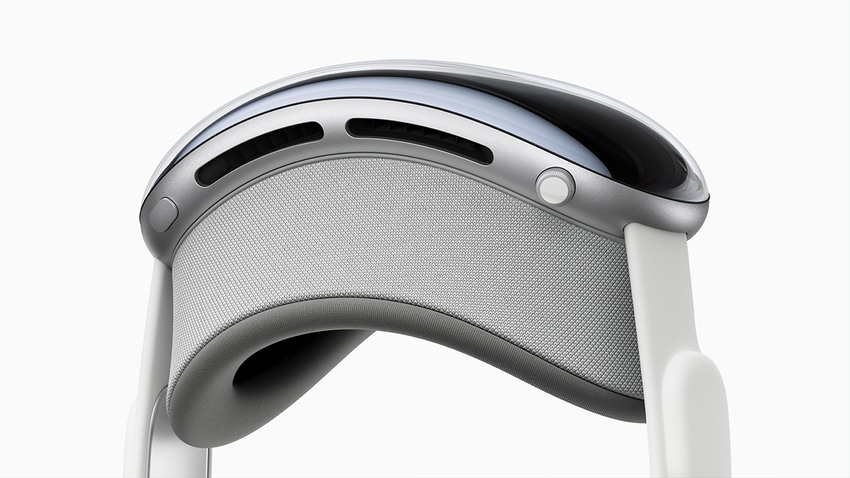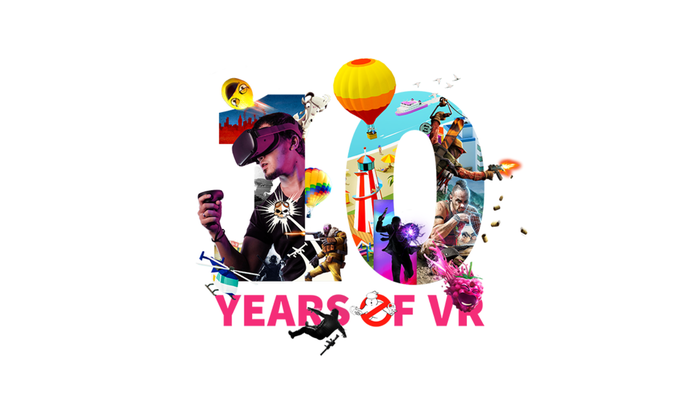5 Reasons Why Apple Vision Pro Is Significant for XR Gaming
I asked a selection of my nDreams colleagues, from across disciplines and development studios, what excites them as game developers about the Apple Vision Pro. Here’s what they had to say.
February 14, 2024

So here it is: after many years of rumours and much anticipation, Apple has finally released its first effort in mixed reality hardware, the Apple Vision Pro. For as long as we’ve been focused on VR (and we celebrated a decade last year!) commentators and industry insiders have excitedly speculated on what an Apple headset might look like, and how it would change the game.
But few people predicted what Apple has brought us with the Vision Pro, a super high-end $3,500 headset that’s as much about work as it is play. Oh, and don’t call it VR (Virtual Reality), AR (Augmented Reality), or even MR (Mixed Reality) – for Apple, this is very much a 'Spatial Computing' headset.
So while there is definitely intrigue around the new hardware in the game development community, some level of hesitancy is understandable. Between the premium price point and an all-new user experience for developers to figure out, there are certainly challenges for anyone jumping straight in.

But for those of us who have been embedded in VR and AR gaming for many years now, there’s a confidence that the hardware will have significant gaming implications and have a massive impact on how we play and make games in the future.
For me, it’s another ‘iPhone moment’. It shows Apple’s vision of the future of computing, with a stunning, intuitive user interface, and technology that demonstrates why so many of us believe that spatial computing/MR will be the next big computing platform. Just like the iPhone launch, it needs compelling software (which is coming), and, like every other technology that has come before, both the cost and size will shrink over the next few years.
(See: "You're Probably Wrong About The VR Games Market", by nDreams CEO Patrick O'Luanaigh, GDC Vault)
So I asked a selection of my nDreams colleagues, from across disciplines and development studios, what excites them as game developers about the Apple Vision Pro. Here’s what they had to say.
Whatever you call it, XR is here to stay
Tomas Gillo, Chief Creative Officer
With any new and developing technology, a common refrain is that it is a “fad”. We’ve always known that XR is no such thing, having grown a team of 250+ over a decade of pure VR games focus, but it’s a stubborn idea that won’t go away.
Apple entering the fray reinforces in the public consciousness that this technology is here for good. The “spatial computing” of Vision Pro is essentially the same AR/MR/VR tech, as far as I can see, but what it does represent is a quality that eclipses its rivals.
But of course, that’s not comparing apples with apples (forgive the pun). The Meta Quest 3 and PS VR2 are fantastic headsets appealing more to the mainstream with their more affordable price points, and right now the Vision Pro is a product for Apple’s core cohort of fans.
This is the start of the next computing paradigm, but it’s a marathon not a sprint. For now, it’s some much-needed competition for Meta and that can only be good for consumers. For us on the development side, it should also herald fresh investment and ongoing R&D to keep reducing friction, increasing utility to users, and finding new use cases to drive adoption.
Being part of the Apple ecosystem also means that when headset prices start to trend downwards, their appeal will expand to hundreds of millions (billions?) of iPhone, Mac, iPad and Apple Watch users. The Vision Pro’s fantastic integration with iOS already paves the way for this.
The Angry Birds-style killer gaming app isn’t there yet, on any headset – Beat Saber is the closest right now – but Vision Pro brings us nearer to finding it.
Another step towards fully mobile mixed reality gaming
Louise Kasemeier, Production Director at nDreams Studio Orbital
What was the key to mobile leading a huge expansion and diversification of the audience for gaming? The simple answer is that suddenly, almost everyone had a powerful, gaming-capable device in their pocket that was accessible and easy to use.
VR, for all its strengths, has never had that. There are challenges around comfort, you can’t see around you, and frankly, many would choose not to wear a traditional headset in a social or public environment.
Apple Vision Pro is not yet a headset to be worn all day, every day, for all things – see Tesla instructing owners not to wear Apple’s headset while behind the wheel, after a series of viral videos – but it is certainly a step towards bringing that mobility and accessibility to an XR device.
There are hints of a future in which people wear a headset like this while doing laundry, catching the bus, or even doing some shopping! Ill-advised or not, we’re already seeing a number of examples of users giving in to this urge.
So what does this mean for gaming? Ultimately, like with mobile, non-gaming apps will broaden the appeal. This in turn exposes more people to AR and VR, for both work and entertainment, and brings in a broad audience who are open to different gaming genres and experiences.
Non-gaming focus opens doors – just look at the App Store
Grant Bolton, VP of Technology
What’s more significant for game development: the establishment of a new gaming platform, or a new computing platform? Logic would suggest the former, but history shows us that gaming is one of the major beneficiaries when computing ecosystems reach widespread adoption.
Just look at how Steam allows us developers to reach anyone with even a basic Windows laptop, or how the App Store and Google Play allow us to reach anyone with a smartphone.
Apple has repeatedly launched products that are powerful and accessible, combining well-designed hardware with software that people love using. They're adept at carefully marketing new product categories to broad audiences. It may take several hardware iterations, but I expect the Vision Pro to gain broader popularity as a device for work, socialising and consuming content.

Quotes from a panel of VR industry experts on the expected impact of Apple entering the XR space
This will allow VR/MR games to gain traction more easily. We'll be able to entertain anyone in Apple's spatial computing ecosystem, without requiring them to buy a dedicated gaming headset.
The way Apple are thinking about spatial computing is also noteworthy and could empower new genres of games; apps that blend the comfort and cinematic power of 'big screen' gaming with the delight, immersion and accessibility of interactive VR/AR content.
Even if gaming is not a priority use case for the device, 3D rendering is at the heart of the entire VisionOS user experience. I expect game devs to benefit from that focus, leveraging Apple's advancements in hardware and software to develop spectacular games and experiences.
Longer session lengths = more diverse gaming experiences
Chris White, Head of nDreams Studio Orbital
When focusing on technology capable of such unparalleled gaming immersion, it’s tempting to focus on the technical advancements we’ll see in the coming years. But good old fashioned comfort and convenience is what will drive the broadest adoption!
Currently, a player’s long-term engagement can be interrupted by ergonomic issues that wouldn’t manifest on traditional flat-screen platforms. To become the primary gaming platform of choice, VR hardware needs to facilitate longer session lengths aligned with player’s expectations.
Following on from positive steps in this regard by Meta and Sony in their latest headsets, Apple’s Vision Pro is a revolutionary step forward ergonomically. It brings advancements in terms of weight distribution to facilitate these longer sessions. You can simply wear it for longer.
This is supported by higher resolution displays, which reduce eye strain, and a superior refresh rate to minimise nausea. Additionally, the ability to dip in and out of the real world – blending realities – reduces friction and the itch to remove the headset as frequently.
After all, what drove the mass adoption of mobile as a gaming platform wasn’t that phones were technically superior to PCs and console, but that you could be comfortably gaming within seconds from any location.
The Vision Pro will enable us as developers to craft a broader and more diverse range of experiences, which in turn attract a wider audience to XR gaming. It’s a ‘mobile’ device, but one in which you can truly submerge yourself in another world, as opposed to viewing that world through a postcard.
’Spatial Computing’ fulfils the promise of mixed reality gaming
Iestyn Lloyd-Wilkins, Lead Programmer at Near Light: an nDreams Studio
As a studio, we’ve always advocated for mixed reality gaming, and the Apple Vision Pro brings high-end examples of this into the public consciousness like never before.
Anyone will be able to walk into an Apple Store, put on a Vision Pro, and experience what it feels like to have games, entertainment, and apps occupy the real world around you, all rendered with incredible fidelity on a device that’s comfortable to wear for long periods of time, all controlled by natural movements of your eyes and hands.
Creatively, there are new freedoms and challenges facing the game development community that will make for some fascinating experiences. Our imaginations can be totally unleashed; just consider games that can adapt to your environment, using your walls, floor and furniture to blend the real world with the fantastical. What doors will this open for storytelling? What design and technical innovations will this inspire?
As developers, we have a whole new way to fill people’s homes with delight and wonder that is no longer constrained by flat screens or completely replacing the world with virtual content. Outside of games, it’s easy to see how things like cooking guides and floating timers anchored over the stove in the kitchen, or enormous high-fidelity screens in your living room to watch films, could become commonplace.

Mixed Reality features of Meta Quest 3 spotlighted with Ghostbusters: Rise of the Ghost Lord
What the Vision Pro solidifies, following advances in this area with Meta Quest 3, is that wearing a headset no longer has to isolate you. With Apple’s EyeSight technology, the front lenticular display allows people on the outside to see your eyes and where you’re looking, and if you decide to go fully immersive using the Digital Crown, anyone who’s physically close to you can be seen inside. No more jump scares!
Read more about:
BlogsAbout the Author(s)
You May Also Like









